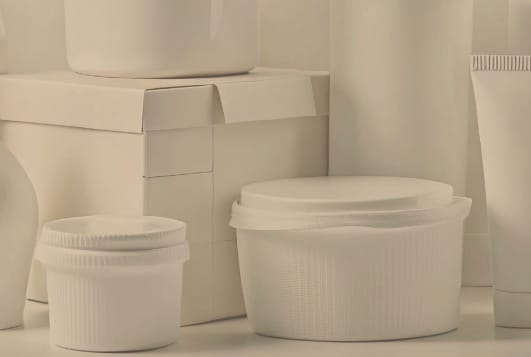The German packaging industry is facing profound structural changes. After strong growth until 2022, the industry has been experiencing a downward trend since then. In 2024, the production value in Germany was around 30 billion euros. Apenberg & Partner is forecasting a further decline to 27.4 billion euros by 2025 and to 26 billion euros by 2026.
The German market is divided into four material groups. Paper, cardboard and cartonboard have a 46% market share, plastic packaging 37%, glass packaging 9% and metal packaging: 8%. Paper, cardboard and cartonboard, in particular corrugated cardboard, recorded the sharpest declines due to the cyclical demand for transport packaging. Paper labels are comparatively stable.
In the plastics segment, the submarkets are developing differently. While sacks and bags are shrinking sharply due to regulatory measures, areas such as closures, bottles/bottles and large containers are recording moderate growth.
Glass packaging is also showing a downward trend in 2023 following a sales peak due to high energy costs. Bottles are experiencing particularly heavy losses, while jars and similar products are less affected.
The metal packaging sector is shrinking by an average of 4.5% per year. Aluminium, non-aluminium and closures are affected to a similar extent.
Industry data underestimates the actual market volume in Germany, as composite packaging and packaging aids are not fully taken into account. The increasing substitution of plastic with paper or bio-based materials has also remained largely invisible in the statistics to date, which limits the informative value with regard to sustainability.
In addition to economic factors, the EU Packaging and Packaging Waste Regulation (PPWR), which comes into force in 2026, will be a key driver of further market developments.
The basis for categorising the packaging market is the material
The Federal Statistical Office collects data on packaging produced on the basis of packaging material. Accordingly, different types of packaging are recorded, enabling a more detailed categorisation of individual goods. A material-dependent categorisation also makes sense from a packaging technology perspective, and not just on the basis of packaging properties and manufacturing processes. A look at the material is particularly important due to the increasing focus on recycling. Accordingly, the market is divided into four clusters: packaging made of paper, cardboard, carton; plastic; glass and metal.
Packaging made of wood is neglected in the study as it is hardly used as a material for commercial packaging. Sales of wooden packaging in 2024 totalled 1.5 billion euros. Of this, 61% is accounted for by pallets, which are indispensable in logistics.
Paper packaging makes up the packaging market
Based on the breakdown of the packaging market into four material groups shown above, the production value in 2024 shows that packaging made of paper, cardboard and paperboard accounts for almost half of total sales. Plastic packaging takes second place with a share of 37%. Glass and metal packaging account for a similarly small share of the market at 9% and 8% respectively.
The complete study, including detailed figures and developments, is available from Apenberg & Partner for a nominal fee of 150.00 euros plus VAT.
Apenberg & Partner
Apenberg & Partner is one of the leading management and personnel consultancies in the printing industry, packaging printing, print media and industrial printing. The focus is on the combination of in-depth industry and methodological knowledge, consistent client-orientation, measurable results and a flexible, innovative approach. Since its foundation in Hamburg in 1987, Apenberg & Partner has successfully implemented over 1,000 projects and accompanied more than 250 medium-sized companies and well-known corporations on their way.

